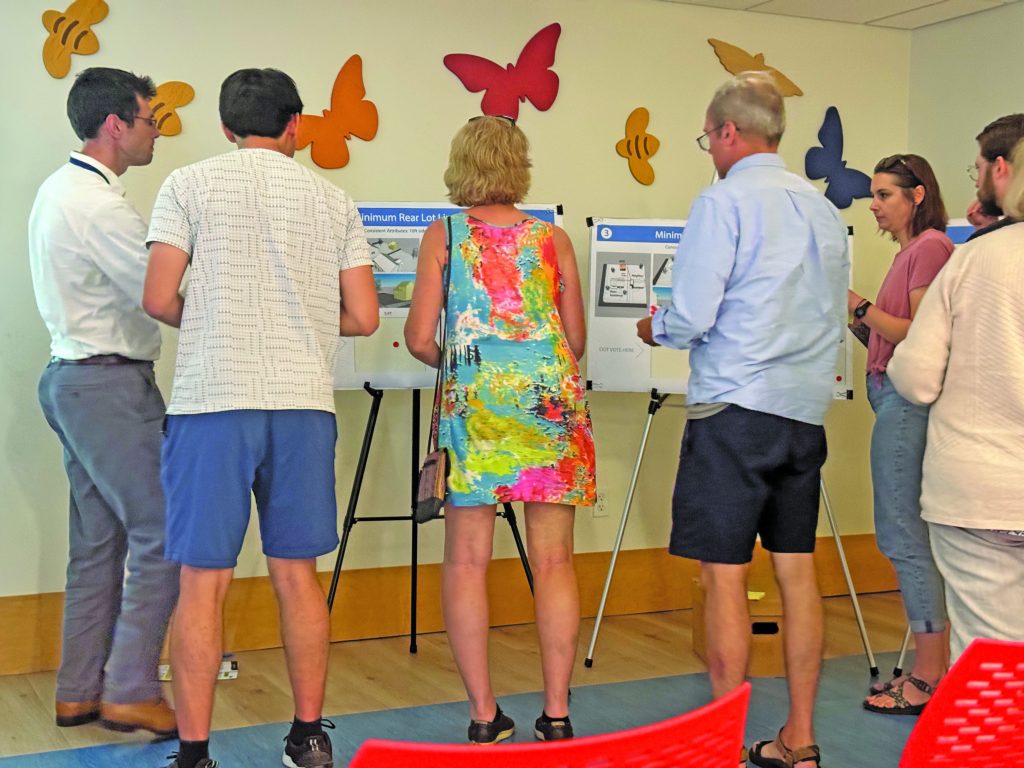Well-Attended First Public Meeting Repeats Sunday

A surprisingly large turnout of more than three dozen citizens at the Mary Riley Styles public library this Tuesday was introduced to the onset of a predicted six-month process to bring the City of Falls Church up to speed with neighboring jurisdictions on making the addition of “accessory dwellings” on existing single family home lots easier and more apt to happen.
While draft legislation to accomplish this has not yet been penned (a first draft from the City’s Planning Department is slated for September), the premiere session this week was intended to set the stage with options and a timeline for gaining City Council approval. A second presentation, scheduled to present the same information as the first, will also be held at the library, this time at 2:30 p.m. this Sunday, July 28.
F.C. Planning Director Paul Stoddard and senior planner Jack Trainor were on hand to lead this Tuesday’s initial presentation.
They began with a definition of what constitutes an “accessory dwelling” (AD) being “smaller, additional dwelling units on the same lot as a single family home…that includes a kitchen, bathroom and entrance.”
While all surrounding jurisdictions have updated their zoning laws to permit the addition of ADs in the recent period, Falls Church is just now getting started. And the large turnout Tuesday suggests the City may be in for another donnybrook like the two-year fight over modification of the City’s slim transitional zones (t-zones) that was finally resolved by a 5-2 vote of the Council last fall.
But the issues are certainly different, and there are plenty of upsides for City homeowners with this proposed improvement. Namely, with home prices skyrocketing here, ADs offer the potential for homeowners to supplement their incomes by renting out ADs on their own home properties to offset the rising costs.
Also, the much smaller homes will make living in Falls Church affordable for many people beyond the immediate families of individual builders (a popular term for ADs is “granny flats” meaning that they can be used to house inlaws), and beyond their use as occasional short term rentals, as in an “Airbnb” use, to become affordable homes for young families who otherwise couldn’t afford to live here.
A glowing endorsement for the move came from a woman at Tuesday’s meeting who is now a City resident but hails from San Diego, California, where, she said, they are called “casitas” and “everybody loves them.”
While Stoddard noted that 73 percent of the City’s land area is within the three residentially-zoned areas of Falls Church that would qualify for ADs, others, including a developer of such entities present, said that their construction is not cheap, and only a couple dozen, at most, might actually be built. But that view did not take into consideration the financial resources of City residents and changing trends in the market, where there is currently a significant housing shortage, and especially of housing that is affordable to a wider range of people.
Trainor explained that there are four common types of ADs, starting with a completely detached building, then an entirely interior apartment (with a separate entrance), a bump-out of an existing primary residence, and a garage conversion. Variations of interior units could be in attics or basements.
The three main benefits of ADs that Stoddard and Trainor identified were 1. They provide an “aging in place” option for local residents (“ADs can provide families with housing options for family members that may need to live nearby,” they said), 2. They offer the prospects of supplemental income for homeowners (“Homeowners may enjoy supplemental income by renting their ADs”), and 3. They enhance diversity (“ADs provide smaller, less expensive housing options than typical detached single-family homes that are ideal for 1 to 3 person households”).
Current zoning regulations, they noted, “are highly restrictive compared to other housing forms in the City. For example, they are currently allowed within an existing, detached single-family home, such as a basement or second floor, and require approval by the Board of Zoning Appeals.”
Among the issues that Stoddard and Trainor are seeking public input about relate to permitted locations, design elements (including setbacks, height, size and lot acreage limits), occupancy and short term rental limits if any, and parking.
In Arlington, for example, short term rental uses require a permit and in Alexandria it is limited to 120 days, while Fairfax County, like Falls Church, has no restrictions currently. Parking currently requires one additional space on the lot.
Questions raised at Tuesday’s meeting dealt with the extent to which the City will promote this use, parking, how ADs would be taxed, has it worked well in other jurisdictions, has there been any serious pushback, and who are the people that can live there (for Falls Church it is currently limited to those “related by blood or marriage” or otherwise up to eight others).
As currently projected, the process is expected to conclude with a final City Council vote on February 25, 2025.